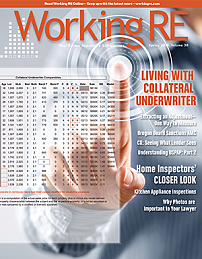 |
>> See Past News Editions >> Click to Print Protect your license and your livelihood with the Expert’s Guide by Tim Andersen, MAI. Click now
|
Why Yours Words Matter (in your appraisals)
by Tim Andersen, MAI
You’ve read about making adjustments, especially when few sales data are available. Articles discuss how to handle an action letter from your state appraisal board. There are articles about writing a clear, persuasive appraisal report. Reports like that don’t get a lot of call-backs from underwriters or nasty notes from reviewers. Let’s take a look at how to write clear, persuasive reports.
Look at “comp” for example. We understand it, but it may be gibberish to buyers who may end up with our appraisal reports. So, when we use “comparable sale” or “comparable rental” instead of “comp,” we are being clear in our writing. Clear writing is persuasive writing, don’t you think? What about words?
Short words are easy to understand. There is no rule-of-thumb but words of more than about 15-letters may defeat the purpose of using short words. Which is clearer to you, a plenipotentiary market, or a strong market? Keep the words short and easy-to-understand. What about sentences?
Individual words make up sentences. If a sentence is easy to follow, it’s easy to understand. So our sentences should be short and jargon free. A short sentence contains one easy-to-follow idea. This is an example of a short sentence. It has eight (8) words. It contains one idea. So, as a general rule, keep sentences so short, with only one idea.
How short? Unless you are quoting somebody or something directly, keep it under 20-words. There is nothing “wrong” with a sentence of more than 20-words. It’s just that when there are too many of them an appraisal report becomes tedious, long, and a challenge to understand (21-words). Make a sentence snappy! Keep it under 20-words (unless there is a really good reason not to).
(story continues below)

(story continues)
Read a sentence in your report out loud to yourself. Do its rhythm and cadence please the ear? Can you read the sentence out loud in one normal breath? When you read that sentence aloud, does it make sense to you? If you got three “yes” answers, then the sentence is the proper length.
Here’s an example of a clunky sentence:
“The appraiser visited the subject property on May 5, 2015 at 8:15AM, met with the property manager and listing broker, inspected the subject’s interior, took the subject photos that accompany this report, inspected the subject’s grounds, drove the subject’s neighborhood, made some preliminary notes on the condition of the subject, and then returned to the office at 9:30 AM.”
This sentence is true and correct. But does is it sizzle? Does it make you want to read more? Does it make you look forward to reading this appraiser’s next report? If it’s clunky, how do we clean it up?
Consider this reconstruction:
“With the property manager and listing broker, the appraiser visited and inspected the subject and its grounds May 5, 2015. All photos of the subject, its interior, and its neighborhood are by the appraiser.”
Keep the chronology in the workfile for future reference. So, are these two snappy sentences easier to read than the clunky one? They communicate the same ideas. Which sentence(s) would you rather read? Now let’s consider paragraphs.
Aren’t paragraphs just connected sentences? But there must be some concrete structure to that connection. Structure is what makes a paragraph stand out as a communication device. We communicate our conclusions via written reports. We persuade with the way we communicate, don’t we? Structure a paragraph in a persuasive and communicative way!
(story continues below)
How? Start with a topic sentence. That’s a short, precise preview of what the paragraph is about. Next should be three or four sentences supporting the topic sentence. These support the topic sentence with logic, reasoning, charts & graphs and comparisons. In these sentences are the analyses, the results of those analyses, and the conclusions those analyses support. Next-to-last come one or two summary sentences. In these, the appraiser makes it clear how the body-sentences support the topic sentence.
Finally, there is a transition sentence leading the reader to the next paragraph. Consider the following example of a well-constructed paragraph:
“Over the last 12 months prices in the subject’s neighborhood have clearly been on the upswing. Over the last three months, the pace appears to have accelerated slightly. This may be a function of the opening of the traditional buying season, however. MLS data in the addendum (by reference) show an increase in both the median listing price and in the median selling price. Those same data show that selling prices for properties such as the subject are up over five percent (5%) year-to-date. Note that there is likely some speculation in this increase. The local population has not increased, unemployment is stable, and so are wages. These indicate that demand is static. There has been no decrease in supply. So, while prices have been increasing, the fundamentals have not followed suit. While this may indicate a speculative component in the market, mortgage money is in ample supply.”
Note that a well-constructed paragraph has a clear beginning, an obvious middle supporting that beginning, and an ending that summarizes the entire paragraph.
Spelling is next! Your word processing program has spell-checker, but it’s not foolproof. For example, their, there and they’re all have exactly the same pronunciation, but their meanings are different. “Their” implies possession or ownership of something. For example, “…their yard maintenance is superb!” “There” is a direction as in, “…that appraiser over there just tripped over the dumb end of his tape!” Finally, “they’re” is a contraction meaning they are as in, “…all of the kids are here, and they’re going swimming!”
Finally, sum up things to the reader. We’ve covered the importance of using short words we all understand. We talked about using precise sentences since they are persuasive, as well as easy to understand and follow. Next we covered well-constructed paragraphs, ones with a clear beginning, middle, and summary-ending. Finally we looked at the need to spell properly. An appraisal with poor spelling persuades the reader the appraiser does not have a lot on the ball.
Finally there is a call to action (which is where the real persuasion takes place). It’s time to write better, more persuasive appraisal reports. Come on! Let’s impress our clients with how good we really are!
Upcoming Webinar
How and Why of Your Appraisals: How to Create a Proper Reconciliation
Presented By: Tim Andersen, MAI
Date: September 10th, 10:00 – 11:30 a.m. PST
“Excellent webinar. I could not write notes fast enough!” – P. Murphy
Effective reconciliation is CRITICAL to communicating the assignment results to the appraisal reader. Learning how to reconcile the information in your appraisal is a proven way to make your clients happy, become a better appraiser, and avoid state sanctions. This webinar includes practical tips and advice from USPAP expert Tim Andersen, MAI, on navigating the crucial, final step of every appraisal- the Reconciliation. See what to include and what to leave out in order to effectively and convincingly tell the story of your appraisal. Avoid call backs and burnish your reputation as a professional with this valuable and important webinar. Sign Up Now!
Fall Webinar Schedule
September: How to Create a Proper Reconciliation – (above)
September: Claims, Complaints, and E&O Insurance – David Brauner
October: Fannie Mae and Q&C Ratings – Richard Hagar, SRA (2 parts)
November: Appraisal Adjustments – Solving Common Problems – Richard Hagar, SRA (2 parts)
Season Ticket: $129 (Save 35% on all six webinars)
Save $78: Get the Season Ticket
>Click to Print
>New: Collateral Underwriter Blog: Find answers, offer solutions.
>Opt-In to Working RE Newsletters
Send your story submission/idea to the Editor: dbrauner@orep.org



by Mike Ford
I’m forwarding a link for this article to all appraisers on my email list.
-by Mike Ford
Excellent article Tim! I’m a run on sentence offender, so this was especially relevant for me.
One missing piece of advice; everyone should buy and study Strunk and White. It’s now the standard writing guide for federal agencies.
lastly, I’m more convinced if I am not asked if I agree. It makes the writer appear unsure of their own point. Don’t you agree?
-by Joseph Mier
Great article………I do try to paint the picture of my site visit and the market. To many times I think we assume that the reader understands our slang when in fact they really do not understand.
-by Mike Ford
Absolutely right!
-by Rachel Massey
Excellent article Tim.
Persuasive writing is critical. As well as being analysts, we are also technical communicators. Communicating in a clear and concise manner is an important aspect of providing clear analysis. If the person reading your report cannot understand it, much is lost.
Keep up the good work.
-by Melissa
EXCELLENT article…
-by anaynomous
the AMC are not reading the reports that are written now. It doesn’t matter how impressive you write if it is not going to be read. Furthermore if I write (for example)
-the car is black, the AMC wants you to say the “the black car”
by Joe Appraiser
You should read the article again.
-